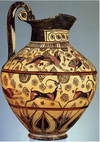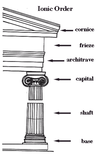Ancient Greece Flashcards

Anicent Greek Parliament - still in use today in Westminster, first created around 600BC

The Olympic Games were a series of athletic competitions among representatives of city-states and one of the Panhellenic Games of Ancient Greece. They were held in honor of Zeus, and the Greeks gave them a mythological origin. The first Olympics is traditionally dated to 776 BC.

The Parthenon is a former temple on the Athenian Acropolis, Greece, dedicated to the goddess Athena, whom the people of Athens considered their patron. Construction began in 447 BC when the Athenian Empire was at the peak of its power. It was completed in 438 BC although decoration of the building continued until 432 BC. It is the most important surviving building of Classical Greece, generally considered the zenith of the Doric order.

Ancient Greek Symposium - drinking party, depicted on pottery

The Grand Tour was the traditional trip of Europe undertaken by mainly upper-class European young men of means, or those of more humble origin who could find a sponsor. The custom flourished from about 1660 until the advent of large-scale rail transport in the 1840s, and was associated with a standard itinerary. It served as an educational rite of passage.

Polis as city-state: An urban centre with monumental architecture, market place, and outer walls for buring the dead outside of and defence. Industrial complexes and quaters, religious communities. People tended to identify as a member of their polis and not as Greek.

Polis as citizen-state. Complex hierachy, democratic political sustem, class hierachy, no votes for women, only adult males whose father was born in that city were considered citizens.

Chora: the hinterland. The agricultural area needed to keep animals and produce food.

The Greek World 550BC. Greece, Islands, Collonies in the Black Sea, Africa, Near East and Western Europe
-Ubia formed the first colony in Naples, and Corinth and Rhodes followed suit

Corinthian Pottery - specialised in minitures, polychrome and depicted hoplites after the 7th c BC.

Rhodes pottery- specialized in wild goat ware, focussing on animals.

Athenian pottery. Red figure (5th c BC) and Black Figure (6th c BC). Depicted abstract and symbolic versions of gods and mythological scenes.

Southern Italian pottery had even more complex shapes and painting. Change in complexity shows chronology.

Nikosthenes - potter who made pots in different, none greek styles as they were made to order

Sculptures would have been painted. Some were hyperrealistic and potraiture was common.

Architecture. Differentiated by the top of the column. A plain capital is doric, a curled capital is Ionic, a capital with leaves is corinthian.

Town planning
Hippodamos of Miletus

Coinage. Everyone had the same form of coinage but engraved with city specific symbols.

Within the household. Split according to gender - Andron was the men’s drinking party room and the domestic areas were for the women to cook and sew at the back of the house

Pleasing the Gods -ceramic tributes to gods show what peoples concerns were and what they were praying for.


